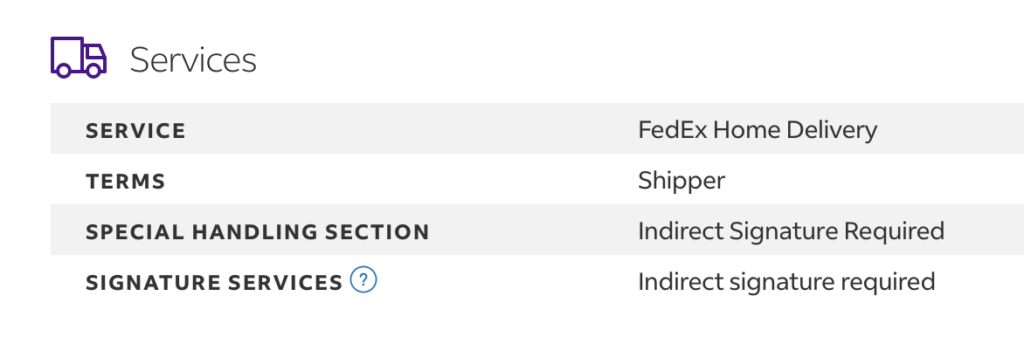What Does Fedex’s “Indirect signature required” Mean?

Fedex’s “Indirect signature required” is a common enough phrase with their shipping, but it has an unclear meaning. Is a signature required or not? What even is an indirect signature? Can it be done online?
Understanding this policy is crucial for both senders and recipients to ensure a smooth and hassle-free delivery process.
Understanding FedEx’s Delivery Policies
When it comes to delivering packages, FedEx has strict protocols and policies in place to make sure that the right package reaches the right person. One of these policies is the requirements sometimes for delivery confirmation, which normally means a signature of some kind.

The Role of Signatures in FedEx Deliveries
Signatures play a significant role in the delivery process as they provide proof of delivery and help in minimizing any disputes or discrepancies. By requiring a signature, FedEx ensures accountability and reduces the chances of a package that was delivered properly seeming like it wasn’t ever received.
When a recipient signs for a package, it serves as a confirmation that the package has been received and accepted. This not only protects the interests of the sender but also provides peace of mind to the recipient, knowing that their package has been successfully delivered.
Furthermore, signatures act as a form of verification, ensuring that the package is delivered to the intended recipient. This is particularly crucial for sensitive or valuable items that require extra care and security during transit.
The Different Types of FedEx Signatures
In FedEx deliveries, there are different types of signatures that can be required depending on the sender’s preferences and the value or nature of the package.
First of all, “No Signature Required” is the most common option. This is when a Fedex person leaves a package at your home or office and then simply leaves. They will often take a picture of the item on your doorstep, but no one at the location confirmed the delivery.
Then we have the confusing “Indirect Signature Required“. This policy allows FedEx to deliver the package but the recipient does not need to be physically present to sign for the package. This can happen in a few ways. First of all, Fedex can received a signature from someone at the location or nearby, for example a doorman, building supervisor, or even a neighbor. These people vouch for the delivery but take no responsibility for the item — they simply confirm that Fedex dropped off the package or parcel as they said they did.
An indirect signature can also be handled by the recipient leaving a signed note or Fedex door tag on their door. This means they do not have to be present at the time of the delivery, but they have OK’ed the delivery.
Lastly, by using FedEx Delivery Manager, a recipient can allow for the drop-off even if they are not present. This is essentially signing online for the package even if you won’t be there to confirm the drop off.
A direct signature is the most secure option, as it requires the recipient or an authorized person to be present at the delivery address to sign for the package. This ensures that the package is handed over directly to the intended recipient, leaving no room for misplacement or theft.
There are type of direct signature required, for instance “Adult signature required” which means that the person at the location who signed for the parcel must be at least 21 years old (in the US, this may vary by country). If no one of sufficient age is available at the location the item will not be left. Age is confirmed by the delivery person using any unexpired government-issued photo ID.
Lastly, a no-signature release option is available for packages that do not require a signature. This option is typically chosen for low-value or non-sensitive items, where the sender is comfortable with the package being left at the recipient’s address without obtaining a signature.
It is important to note that the type of signature required may vary depending on the sender’s instructions and the specific circumstances of the delivery. FedEx provides these options to cater to the diverse needs and preferences of their customers.
Decoding “Indirect Signature Required”
Now let’s focus on understanding the specific meaning of “Indirect Signature Required.” This term generally refers to the requirement for a signature from someone at the recipient’s address, but not necessarily the intended recipient themselves.
The Definition of “Indirect Signature Required”
An “Indirect Signature Required” implies that any adult person at the delivery address can sign for the package on behalf of the recipient. It does not have to be the recipient specifically, but someone responsible or authorized to accept deliveries on their behalf.
When a package is marked with “Indirect Signature Required,” it means that the courier will not leave the package unattended at the doorstep or with a neighbor. Instead, they will require someone at the delivery address to provide a signature to confirm receipt of the package. This additional layer of security ensures that the package reaches the intended recipient or a designated representative.
For example, if you are expecting a package but won’t be available to receive it personally, you can authorize a family member, a friend, or a neighbor to sign for it on your behalf. This flexibility allows you to ensure the safe delivery of your package even when you are not present at the delivery location.
When is an Indirect Signature Required?
FedEx requires an indirect signature for certain deliveries that are deemed to have a higher risk of being lost or stolen. This policy is usually applied to packages with high value, sensitive contents, or shipments to locations with increased security concerns.
By requiring an indirect signature, FedEx aims to minimize the chances of packages falling into the wrong hands or being left unattended in vulnerable areas. This added level of security provides peace of mind for both the sender and the recipient, ensuring that valuable or sensitive items are delivered safely.
It is important to note that not all packages require an indirect signature. FedEx carefully assesses the risk factors associated with each shipment and determines whether an indirect signature is necessary. Factors such as the package’s value, contents, and destination play a role in this decision-making process.
For instance, if you are shipping a package containing expensive electronics or confidential documents, FedEx may require an indirect signature to ensure that only authorized individuals receive the package. Similarly, if you are sending a package to a location known for security concerns, an indirect signature may be necessary to prevent unauthorized access.
Ultimately, the goal of requiring an indirect signature is to enhance the security and reliability of the delivery process. By ensuring that someone responsible or authorized signs for the package, FedEx minimizes the risk of loss, theft, or misdelivery, providing a higher level of service for both senders and recipients.
The Process of Indirect Signature Delivery
Now that we understand the meaning of “Indirect Signature Required,” let’s explore the process involved in delivering packages under this policy.
When a package requires an indirect signature, the FedEx delivery person will attempt the delivery at the specified address. If someone is available to sign for the package, they will collect the signature and complete the delivery process. However, if no one is available, the process becomes more intricate and involves several steps to ensure the package reaches its intended recipient.
Steps Involved in Indirect Signature Delivery
When the delivery person arrives at the address and finds no one available to sign for the package, they initiate a series of steps to ensure a successful delivery or provide alternative options to the recipient.
- The FedEx delivery person will leave a door tag with instructions for the recipient. This door tag serves as a notification that a delivery attempt was made and provides guidance on the next steps to be taken.
- The recipient can then follow the instructions on the door tag to reschedule the delivery or opt for other available options. These options may include selecting a specific date and time for delivery, redirecting the package to a different address, or even authorizing the delivery without a signature.
- Sometimes, the recipient may choose to sign the door tag, authorizing FedEx to leave the package at a safe location. This option is particularly useful when the recipient knows they won’t be available for future delivery attempts but still wants to receive the package securely.
By providing these alternative options, FedEx ensures that even if the recipient is unavailable during the initial delivery attempt, they can still receive their package in a convenient and secure manner.
What Happens if No One is Available to Sign?
If no one is available to sign for the package and the recipient has not provided further instructions, the FedEx delivery person will make multiple attempts on subsequent days. These additional attempts are made to ensure every opportunity is given for the package to be successfully delivered.
If, despite the repeated attempts, the delivery remains unsuccessful, the package may be returned to the sender. This ensures that the package does not remain in transit indefinitely and can be handled appropriately. Alternatively, the recipient may be notified to pick up the package at a local FedEx office, providing them with the convenience of retrieving their package at a nearby location.
Overall, the process of indirect signature delivery involves careful coordination between the delivery person and the recipient to ensure a successful delivery. By offering various options and making multiple attempts, FedEx strives to provide a seamless and customer-centric experience for package recipients.

Rights and Responsibilities of the Recipient
As a recipient, it’s essential to be aware of your rights and responsibilities when an indirect signature is required.
Your Rights as a FedEx Recipient
As a FedEx recipient, you have the right to expect a secure and reliable delivery process. FedEx is responsible for ensuring that your package reaches you in good condition and in a timely manner. If you have any concerns or issues with the delivery, you have the right to contact FedEx for assistance.
Your Responsibilities When an Indirect Signature is Required
When an indirect signature is required, it is your responsibility to ensure that someone will be available at the delivery address to sign for the package. If you anticipate not being available, you can make alternative arrangements with FedEx, such as rescheduling the delivery or authorizing them to leave the package in a specific location.
Troubleshooting Common Issues
Despite FedEx’s best efforts, there can be instances when issues arise with deliveries requiring an indirect signature. Let’s discuss some common problems and how to address them.
Dealing with Missed Deliveries
If you missed a delivery attempt, don’t panic. Follow the instructions left on the door tag, which may include options for rescheduling the delivery or picking up the package from a nearby FedEx location.
Resolving Disputes and Complaints
If you have any disputes or complaints related to an indirect signature delivery, the first step is to contact FedEx customer service. They will assist you in resolving the issue and provide guidance on the next steps to ensure a satisfactory outcome.
By understanding what FedEx’s “Indirect Signature Required” means and being aware of the process and your rights as a recipient, you can have a more informed and smoother experience when receiving packages through this delivery policy.
